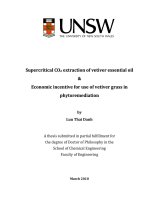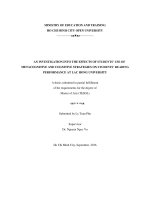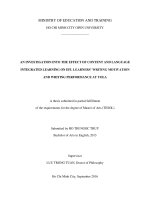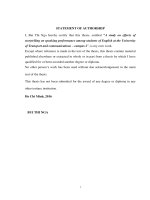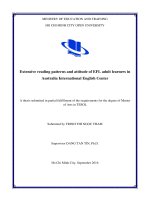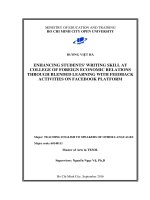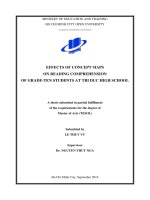The effects of phrase reading on EFL students reading comprehension at hoa binh junior high school a thesis submitted in partial fulfillment of the requirements for the degree of master of arts in TESOL
Bạn đang xem bản rút gọn của tài liệu. Xem và tải ngay bản đầy đủ của tài liệu tại đây (2.5 MB, 149 trang )
MINISTRY OF EDUCATION AND TRAINING
HO CHI MINH CITY OPEN UNIVERSITY GRADUATE SCHOOL
--------------------------------------
LE THI THANH HOA
THE EFFECTS OF PHRASE READING
ON EFL STUDENTS’ READING COMPREHENSION
AT HOA BINH JUNIOR HIGH SCHOOL
Major: TEACHING ENGLISH TO SPEAKERS OF OTHER LANGUAGES
Major code: 60140111
MASTER OF ARTS IN TESOL
Supervisor: LE HOANG DUNG (PhD.)
Ho Chi Minh City, 2020
i
STATEMENT OF AUTHORSHIP
I certify that this thesis entitled “The Effects of Phrase Reading on EFL Students’
Reading Comprehension at Hoa Binh Junior High School” is my own work.
Except where references is made in the text of the thesis, this thesis does not contain
material published elsewhere or extracted in whole or in part from a thesis by which
I have qualified for or been awarded another degree or diploma.
No other person’s work has been used without due acknowledgement in the main
text of the thesis.
This thesis has not been submitted for the award of any degree or diploma in any
other tertiary institution.
Ho Chi Minh, 2020
Le Thi Thanh Hoa
ii
ACKNOWLEDGEMENTS
I would like to express my deepest gratitude to all the people who have helped me
for the completion of this thesis.
First and foremost, I wish to express my deepest gratitude to my supervisor, Dr. Le
Hoang Dung for his expert guidance, full support, understanding and
encouragement throughout my research. Without his patience and timely advice, my
thesis work could not have been done.
Secondly, huge thanks go to the teachers and students at Hoa Binh junior high
school who have been so helpful and patient to me. They are always willing to
support me and give me great opportunity to conduct this research.
Finally, my special thanks go to my family members who have supported me with
everything so that I could concentrate on this thesis. I would not have been able to
complete this thesis without their continuous encouragement and unconditional
support.
Le Thi Thanh Hoa
iii
LIST OF ABBREVIATIONS
CG: Control Group
EFL: English as a Foreign Language
EG: Experimental Group
ESL: English as a Second Language
HBJHS: Hoa Binh Junior High School
L1: First Language
L2: Second Language
M: Mean
N: Number
SD: Standard Deviation
PR: Phrase Reading
SLA: Second Language Acquisition
SPSS: Statistical Package for Social Sciences
RCT: Reading Comprehension Test
iv
ABSTRACT
Concerning the importance of reading comprehension and the potential use
of phrase reading in language learning, the current study aimed at investigating (1)
the effects of phrase reading on EFL students’ reading comprehension, (2) students’
attitude towards the use of phrase reading, and (3) the difficulties of using phrase
reading in the EFL classrooms. There were 169 eighth-graders of Hoa Binh junior
high school involved in this study. The overall findings indicated that phrase
reading strategy had positive effects on students’ reading comprehension. Besides,
students had positive attitude towards the employment of phrase reading and
expressed their willingness to use phrase reading strategy for further learning. Also,
the study discovered some critical challenges that students encountered when using
phrase reading strategy. The findings have offered intriguing implications for the
employment of phrase reading strategy in secondary school in Vietnam and other
language learning contexts.
Keywords: phrase reading, reading comprehension, attitude, challenges
v
TABLE OF CONTENT
STATEMENT OF AUTHORSHIP ............................................................................ i
ACKNOWLEDGEMENTS ....................................................................................... ii
LIST OF ABBREVIATIONS ................................................................................... iii
ABSTRACT .............................................................................................................. iv
TABLE OF CONTENT ..............................................................................................v
LIST OF TABLES AND FIGURES ....................................................................... viii
CHAPTER 1 – INTRODUCTION .............................................................................1
1.1 Background of the study....................................................................................1
1.2 Statement of the problem ..................................................................................2
1.3 Aims of the study ..............................................................................................3
1.4 Research questions ............................................................................................3
1.5 Significance of the study ...................................................................................4
1.6 Scope of the study .............................................................................................4
1.7 Definitions of the key terms ..............................................................................4
1.8 Organization of the thesis .................................................................................5
CHAPTER 2 - LITERATURE REVIEW ...................................................................6
2.1 Overview of reading comprehension ................................................................6
2.1.1 Definitions of reading ................................................................................6
2.1.2 Concept of reading comprehension............................................................8
2.1.3 Taxonomy of reading comprehension........................................................9
2.2 Overview of phrase reading ............................................................................11
2.2.1 Definitions of phrase reading ...................................................................11
2.2.2 The benefits of phrase reading .................................................................11
vi
2.2.3 Phrase reading instruction ........................................................................13
2.3 Previous studies on the effects of phrase reading on reading comprehension 15
2.4 Research gap ...................................................................................................23
2.5 Conceptual framework ....................................................................................25
2.6 Chapter summary ............................................................................................27
CHAPTER 3 - RESEARCH METHODOLOGY .....................................................28
3.1 Research design ...............................................................................................28
3.1.1 Mixed-methods research design...............................................................28
3.1.2 Research hypotheses ................................................................................29
3.2 Research site and participants .........................................................................30
3.3 Research instruments ......................................................................................32
3.3.1 Reading comprehension tests ...................................................................32
3.3.2 Questionnaire ...........................................................................................35
3.3.3 Focus group interview ..............................................................................36
3.4 Research procedure .........................................................................................37
3.5 Pilot study........................................................................................................39
3.6 The experiment................................................................................................42
3.7 Data analysis ...................................................................................................46
3.8 Reliability and validity of the study ................................................................47
3.8.1 Reliability .................................................................................................47
3.8.2 Validity .....................................................................................................48
3.9 Research ethics ................................................................................................49
3.10 Chapter summary ..........................................................................................50
CHAPTER 4 – RESULTS, FINDINGS AND DISCUSSION .................................51
vii
4.1 Results and findings ........................................................................................51
4.1.1 Statistical analysis of the reading comprehension test results .................51
4.1.2 Analysis of data from questionnaire ........................................................61
4.1.3 Analysis of data from interview ...............................................................71
4.2 Discussion .......................................................................................................77
4.2.1 Effects of phrase reading on students’ reading comprehension...............77
4.2.2 Students’ attitude towards the implementation of phrase reading. ..........81
4.2.3 Challenges of using phrase reading strategy encountered by the students
...........................................................................................................................82
4.3 Chapter summary ............................................................................................85
CHAPTER 5 –SUGGESTIONS AND CONCLUSIONS ........................................86
5.1 Summary of findings .......................................................................................86
5.2 Suggestions for teachers and students .............................................................87
5.2.1 Suggestions for teachers ...........................................................................87
5.2.2 Suggestions for students...........................................................................88
5.3 Limitations of the study and recommendations for further studies ................88
5.4 Chapter summary ............................................................................................90
REFERENCES ..........................................................................................................91
APPENDICES...........................................................................................................98
viii
LIST OF TABLES AND FIGURES
Table 2. 1 - Summary of previous studies on the effects of phrase reading on
reading comprehension .............................................................................................22
Table 3. 1 - Description of the participants ..............................................................31
Table 3. 2 – Summary of RCTs’ descriptions............................................................34
Table 3. 3 - Description of participants in the pilot study ........................................40
Table 3. 4 - Description of reliability statistics of RCTs in the pilot study...............41
Table 3. 5 – A lesson plan model for the EG and CG ...............................................44
Table 3. 6 - Description of reliability statistics of RCTs in the main study ..............48
Table 3. 7 - Reliability statistics of the questionnaire...............................................48
Table 4. 1 – Summary of t-test result for the pre-test ...............................................51
Table 4. 2 - Summary of t-test result of CG after the treatment ...............................52
Table 4. 3 - Summary of t-test result of EG after the treatment................................53
Table 4. 4 - Summary of t-test result of post-test ......................................................53
Table 4. 5 - Summary of t-test result for delayed post-test of CG ............................54
Table 4. 6 - Summary of t-test result for delayed post-test of EG .............................54
Table 4. 7 - Summary of t-test result for two levels of comprehension scores before
the treatment..............................................................................................................55
Table 4. 8 - Summary of t-test result for literal comprehension and inferential
comprehension score of CG ......................................................................................56
Table 4. 9 - Summary of t-test result for literal comprehension and inferential
comprehension score of EG ......................................................................................57
Table 4. 10 - Summary of t-test result for the pre-test and post-test of poor readers
...................................................................................................................................58
Table 4. 11 - Summary of t-test result for the pre-test and post-test of good readers
...................................................................................................................................58
ix
Table 4. 12 - Summary of t-test result for literal comprehension and inferential
comprehension scores of good readers .....................................................................59
Table 4. 13 - Summary of t-test result for literal and inferential comprehension
scores of poor readers ...............................................................................................60
Table 4. 14 - Students’ attitude towards PR strategy ...............................................62
Table 4. 15 - Students’ attitude towards the benefits of PR ......................................63
Table 4. 16 - Participants’ attitude towards the instruction .....................................65
Table 4. 17 - Participants’ attitude towards the activities ........................................67
Table 4. 18 - Likelihood of further learning with PR strategy..................................69
Figure 1 – Elements of reading (adapted from Oakhill, Cain, & Elbro, 2015, p. 3) ..7
Figure 2 - Components of reading comprehension (adapted from RAND Reading
Study Group, 2002, p. 11) ...........................................................................................8
Figure 3 - Conceptual framework of the study ..........................................................26
Figure 4 - Procedure of the study..............................................................................38
1
CHAPTER 1 – INTRODUCTION
Chapter 1 describes the statement of the problem as well as the purposes of
the present research. The significance of the study and research questions will be
also clarified in this chapter.
1.1 Background of the study
Reading, together with writing, is one of the hallmark activities that
differentiate humans from other kinds of animals (Wallot, Hollis, & Rooij, 2013).
Indeed, reading is a fundamental element in today's society and in language
learning. In language learning, the significance of reading skills cannot be denied. It
is widely acknowledge that the ability to read in L2 can be considered as one of the
most important skills for students, especially in an international setting. Among
various aspects of language reading skills, reading comprehension has been one of
the most important. To emphasize the importance of comprehension, Katims (1997)
and Duke and Pearson (2002) added that reading without comprehension is
pointless or simply word barking. Accordingly, there has been an increasing interest
in reading comprehension in recent years (Kaplan, 2002).
On the other hand, English is a foreign language for Vietnamese students. It
is certainly not easy for students to comprehend English texts. Moreover, it is
reported that the average reading level of the eight graders at Hoa Binh junior high
school is rather low (see Appendix 14 for detailed students’ reading scores). In
particular, students’ ability of reading comprehension is limited. Additionally, by
observing the EFL classrooms at this school, it is recognized that most of the
language teachers spend most of the time asking learners to look for words’
meanings and translating the reading texts word-by-word into Vietnamese. Hence,
there is a need to foster students’ reading comprehension at this site with the
employment of alternative reading methods or strategies. PR has not been employed
at this campus before and the students are at low-English-proficiency level; thus,
2
these reasons paved the way to conduct the current research using PR to enhance
students’ reading comprehension at this school.
1.2 Statement of the problem
A great amount of effort has been made with the purpose of fostering reading
comprehension of language learners in their learning process. It is acknowledged
that phrase reading can facilitate reading comprehension. Phrase reading (PR) is the
“process of organizing or clustering information into compact thought units, such as
phrases or clause (Valentine & Franks, 1970, p. 48). A good number of researchers
have pointed out that PR has beneficial impact on learners’ reading comprehension
(Anggraeni, 2015; Klella, 2017; Sekitani, 2017). Nonetheless, many studies have
shown that no remarkable relationship between PR and reading comprehension
development has been found (Komaba, 1992; Yamashita & Ichikawa, 2010;
Yokono, 2016). It can be seen that there are inconsistent results across previous
research investigating the influence of PR on language learners’ reading
comprehension. Moreover, there is a controversy over the effects of PR on good
readers and poor readers’ comprehension. Besides, it is shown that most of the
previous studies in L2 context are conducted on adult and high English-proficiencylevel students. Additionally, the previous studies have not legibly determined which
levels of comprehension are involved in the research. As a result, there is a need to
investigate the effects of PR on low-language-proficiency level students’ reading
comprehension at primary or secondary schools.
Overall, there is still a controversy over the influence of PR on learners’
reading comprehension development. The impact of PR on low-languageproficiency-level learners at primary or secondary schools have not been
sufficiently investigated, especially in L2 context. Although students’ perception is
one of the most essential factors that significantly influence the success of a strategy
or approach in language learning, most of the previous studies have not investigated
learners’ perceptions of the implementation of PR in the EFL classrooms. As a
3
result, there should be more studies that examine participants’ attitudes towards PR.
Furthermore, many studies have suggested that there should be new study
examining the difficulties that the students may have when using PR in their EFL
classrooms (Nishida, 2013; Yamashita & Ichikawa, 2010). However, few studies
have fulfilled this purpose. On the other hand, PR is not popular in Vietnam and
few studies have been done with the aim of investigating the influence of PR in
Vietnamese context (Le, 2014). Therefore, it is necessary to verify the influence of
PR on reading comprehension of low-language-level learners in Vietnam.
1.3 Aims of the study
Based on the research gap that paved the way to for carrying out the current
research, the current study was an attempt to investigate the effects of phrase
reading on EFL students’ reading comprehension in terms of the reading
comprehension test scores. Furthermore, the research examined students’ attitude
towards the use of phrase reading. Also, the difficulties of using phrase reading in
the EFL classrooms were identified. The study was conducted in order to gain a
deeper insight of the effect of phrase reading on reading comprehension
improvement.
1.4 Research questions
In order to obtain these purposes, the research was conducted to answer the
following questions:
1. Does phrase reading have positive effects on EFL students’ reading
comprehension?
2. What are students’ attitudes towards the use of phrase reading?
3. What are the difficulties of using phrase reading encountered by students in
the EFL classrooms?
4
1.5 Significance of the study
The research was carried out in purpose of finding a way to develop
students’ reading comprehension at HBJHS. If the use of PR is proved to be
effective, the teachers can use it as regular classroom instruction to support their
teaching. Also, this study was expected to raise the awareness of the role of reading
comprehension and PR in language teaching and learning in this context. It would
also provide some useful implications for teaching and learning L2 reading.
Besides, the findings of the current research might be generalized to other
secondary schools in Vietnam.
1.6 Scope of the study
This study focused on the employment of phrase reading on young learners
in EFL reading classrooms at Hoa Binh junior high school. Also, the study
investigated the effects of phrase reading on students’ reading comprehension.
Besides, the study identified the students’ attitude towards the implementation of
phrase reading and the difficulties of using this strategy encountered by students.
1.7 Definitions of the key terms
Attitude - a tendency to respond positively or negatively towards a certain
phenomenon
Difficulty - problem or challenge that needs attention and needs to be dealt
with
Reading - the process of looking at a series of written symbols and getting
meaning from them
Reading comprehension – the process of simultaneously extracting and
constructing meaning through interaction and involvement with written language
Phrase reading – a strategy of reading by chunking and organizing individual
words into meaningful word groups in order to foster fluency and comprehension
5
1.8 Organization of the thesis
This paper is organized into 5 chapters with an introduction to each chapter.
Chapter 1 consists of statement of the problem, aim of the research, research
questions, and the significance of the study as well as organization of the thesis.
Chapter 2 focuses on the theoretical framework of PR, beginning with an overview
of reading comprehension and PR. Next, there is a section which presents the
review of previous research on the influence of PR on learners’ reading
comprehension and research gap for conducting the current study. Chapter 3
describes the research methodology involving the design of the study and the
procedure for conducting the experiment. The methodological procedures including
the main points such as the information of participants, settings, sampling method,
the research instruments, the treatment, data collection and methods of data analysis
have been presented. Data collected from students’ reading comprehension score,
questionnaire and interview will be analyzed and discussed in chapter 4. The last
chapter presents the conclusion of the paper founded on the findings and
discussions in the preceding chapters. Suggestions for further research, implications
for teachers and students will be offered to assure the efficacy of using PR in EFL
classes. Lastly, some limitations of the study will be acknowledged in the final
chapter.
6
CHAPTER 2 - LITERATURE REVIEW
This chapter first describes an overall picture of reading comprehension in
language learning. Then, the definitions and instructions of PR are also included.
Finally, the chapter reviews the previous research associated with the effect of PR
on reading comprehension and research gap for conducting the present study.
2.1 Overview of reading comprehension
2.1.1 Definitions of reading
Reading is an essential element in society and in language learning now. It is
widely acknowledged that the ability to read in L2 can be seen as one of the most
fundamental skills acquired by students, especially in an international setting. First
and foremost, it is crucial to obtain the definitions of reading. Reading can be
described as the act of extracting meaning from a reading text; however, this
definition is insufficient. Hence, various researchers have provided different
definitions of reading. Definitions of reading range from the descriptions of two
main components of reading to various complicated definitions to capture the
notion of reading. A good number of contemporary definitions of reading
concentrate on two fundamental elements of reading. For instance, Ur (1996)
maintains that reading means reading and understanding. To illustrate her point, she
gave an example that ‟a foreign language learner who says, ‘I read the words but I
don’t know what they mean’ is not, therefore, reading in this sense” (p.138). In this
case, the learner was simply decoding and transferring letter patterns into equivalent
sounds. In harmony with Ur’s point of view, Oakhill, Cain and Elbro (2015) clarify
these two major elements of reading, including word decoding and language
comprehension.
7
Figure 1 – Elements of reading (adapted from Oakhill, Cain, & Elbro, 2015, p. 3)
Decoding is capacity of using knowledge of letter patterns to recognize and
read the words. Comprehension relates to the capacity of understanding at different
levels including words, sentences, and texts. Figure 1 demonstrates the relationship
of the two fundamental elements of reading. If the reader lacks either of the
components, s/he cannot read. This definition emphasizes the importance of two
essential components of reading, namely word decoding and comprehension and the
interdependent relationship between these two aspects. On the other hands,
Schoenbach, Greenleaf, Cziko and Hurwitz (1999) provide a more detailed
definition of reading by asserting that reading is a “complex process of problem
solving in which the reader works to make sense of the text not just from the words
and sentences in the page but also from the ideas, memories and knowledge evoked
by those words and sentences” (p. 38). It can be seen that reading comprehension is
not just an effortless process but it involves the reader’s manipulation of diverse
cognitive abilities. Furthermore, Pang, Muaka, Bernhardt and Kamil (2003) define
reading as a complex activity in which the reader communicates with the author.
Indeed, reading does not only mean to lift the words off the page but it is a means of
interpreting meaning.
On the basis of the definitions given by the researchers and authors
mentioned above, reading can be described as a complex process of problem
8
solving in which the reader decodes and understands the written texts. This
definition serves as a foundation for further discussion of the current study.
2.1.2 Concept of reading comprehension
Reading comprehension is a fundamental aspect in reading and language
learning. Over the years, various researchers have offered different definitions of
reading comprehension; however, full consensus on the definition of reading
comprehension continues to elude those who examine it. RAND Reading Study
Group (2002) maintained that reading comprehension is “the process of
simultaneously extracting and constructing meaning through interaction and
involvement with written language” (p.11).
Figure 2 - Components of reading comprehension (adapted from RAND Reading Study
Group, 2002, p. 11)
The two words ‘extracting’ and ‘constructing’ were used to highlight the
significance and inadequacy of the text as a decisive factor of reading
comprehension. As such, comprehension includes three components: (1) the learner
(i.e. reader), (2) the reading text, and (3) the activity of comprehending. Similarly,
Pang et al. (2003) have described reading comprehension as the activity of
obtaining meaning of the reading text which involves reader’s ability to decode and
mental processing. This definition illuminates the essence of comprehension which
requires the learner to actively engage with the texts to establish the meaning of the
text by using their prior knowledge and making inferences from the texts.
9
According to Brassell and Rasinski (2008) the term ‘comprehend’ originates from
the Latin word ‘prehendere’ which means ‘to grasp’. It means that reading
comprehension is a dynamic activity in which meaning cannot “magically” appears
once the reader reads the words in the text. More specifically, the readers need to
actively engage with the texts and transform the information by using their own
mental processes in order to comprehend what they have read beyond narrating the
facts of the written text. Therefore, reading comprehension can be defined as “the
ability to take information from written text and do something with it in a way that
demonstrates knowledge or understanding of that information” (Brassell &
Rasinski, 2008, p. 18).
In brief, reading comprehension is an active process of interacting with the
text to comprehend or construct meaning from the text and to integrate it with
readers’ background knowledge. As such, the researcher used this definition as the
operational definition of the current research.
2.1.3 Taxonomy of reading comprehension
To assist the teachers in developing students’ reading comprehension and in
designing RCT, different levels of reading comprehension are classified according
to the degree of complexity. Brassell and Rasinski (2008) listed three-level
taxonomy of reading comprehension which was originally proposed by Thomas
Barrett as follows,
Literal comprehension is the starting point for understanding of what is
being communicated encompassing the comprehension of the details directly
presented in the texts. As the lowest of the three levels, literal comprehension
relates to the recognition and understanding of words in the text which involves
students’ ability to recall or locate the details of the texts such as names of
characters and detail of the setting.
10
Inferential comprehension is the next level of comprehension which
requires the learner to understand the information implicitly stated within a text.
Inferential comprehension is more complicated than literal comprehension since it
involves organizing the information of the reading texts and their background
knowledge. Inferential comprehension pertains making inferences about things
implicitly stated such as main idea of the text, writer’s purpose, author’s attitude or
the tone of the passage.
Critical or evaluative comprehension is the last level in the taxonomy
which demands evaluating and judging the ideas embedded in the texts.
For
instance, the questions used to assess evaluative comprehension are Do you agree
or disagree with these messages? How did this text make you feel? Do you agree
with the character’s behavior in a particular situation? What would you change
about the text if you were the author? Responses to critical-level questions demand
in-depth analysis and critical thinking. Hence, answers to these questions are highly
dependent on many aspects of the readers such as their background, level, interest
and disposition.
All three levels of comprehension are crucial and should to be developed.
Nonetheless, an emphasis on literal comprehension and inferential comprehension
is appropriate for elementary English proficiency level students.
Critical
comprehension would be expected to find in higher level EFL classrooms.
Accordingly, the current study delved into a deeper investigation into the influence
of PR on reading comprehension by deliberating two levels of reading
comprehension namely literal comprehension and inferential comprehension. The
review above provides the foundation for designing the conceptual framework,
RCTs and further discussion of the study.
11
2.2 Overview of phrase reading
2.2.1 Definitions of phrase reading
Over the years, various researchers have offered different reading strategies
for the development of students’ reading comprehension. Anderson (1991)
describes reading strategies as cognitive steps that allow the learners to obtain, store
and recall information. Among various reading strategies, phrase reading (PR), also
known as chunk reading, has raised a great amount of interest among the
researchers in the world. PR, in the most basic sense, is the act of segmenting words
into meaningful units while reading. In other words, PR is the “process of
organizing or clustering information into compact thought units, such as phrases or
clause (Valentine & Franks, 1970, p. 48). Similarly, Casteel (1988) deduced that
chunking or phrasing is the act of segmenting and organizing individual words into
meaningful units which typically arrange from three to five words. To provide a
more detailed definition, Henk (1986, as cited in Nichols, Rupley, & Rasinski,
2009, p. 7) defines PR as an “excellent strategy for promoting students’ ability to
read in syntactically appropriate and meaningful idea units or phrases, in order to
understand what they read, and to increase automaticity in word recognition and
enhanced comprehension”. Furthermore, Dechant (1991) argues that PR is a process
which involves lexical access, semantic encoding, assembly of propositions,
chunking, microselection, and integration of propositions.
In short, PR is a strategy of breaking down and organizing a text into
different but related thought groups or meaningful units, such as phrases or clauses,
then reading these parts phrase-by-phrase. This definition will be applied as the
main definition for the current study.
2.2.2 The benefits of phrase reading
PR is proved to be a fruitful way for enhancing reading comprehension due
to various reasons.
12
In the first place, PR increases learner’s capability of extracting information
from the context despite constant cognitive restraint. Miller (1956) asserts that “the
span of absolute judgment and the span of immediate memory impose severe
limitations on the amount of information that we are able to receive, process, and
remember” (p. 95). By concurrently arranging the stimulus input into a chain of
chunks, learners are able to overcome this informational obstruction.
Secondly, PR process contributes to avoid word-by-word reading which may
cause lack of comprehension. Cromer (1970) asserts that reading in word-by-word
fashion which is often favored by poor readers, dismisses readers the chance of
getting the meaning conveyed in the texts. Reading a text in individual word
manner, learners probably forget the beginning of a sentence before they get to the
end (Casteel, 1988). If the learners concentrate on individual units, they probably
fail to get larger meaning of the passage or sentence. Moreover, it is found that good
readers tend to process information in syntactic-chunking manner; meanwhile poor
readers are rather dependent on individual words (Clay & Imlach, 1971). Hence,
reading a text in meaningful phrases enables learners to get the gist of the text or
sentence instead of processing the meanings of separate units.
Thirdly, PR promotes the brain to enhance the channel capacity of short term
memory. Miller (1956) depicts that learners can store more information if they
segment or connect some pieces of information. Indeed, human mind cannot
consistently keep in short-term memory more than approximately four to seven
separate words. Thus, learners should expand short-term memory for elements with
low-information-content by mentally “recoding” them into a smaller number of
high-information-content elements.
Furthermore, PR facilitates information building-up in long-term memory.
Casteel (1988) emphasizes that chunking words into phrases allows learners to
transmit information from short-term memory (where information is initially
obtained) to long-term memory (where comprehension is achieved). The notion of
13
chunking makes clear why experts can memorize greater amount of information
than novices despite the limit of short-term memory capacity. Therefore, good
reader can store more information by chunking the information into meaningful
pieces that have been built up in long-term memory instead of storing individually
unit in short-term memory.
Last but not least, PR may minimize the overload of information. According
to Sweller (1988), the amount of information and interactions which are processed
concurrently can either excess the restricted size of learner’s memory. If
overloaded, all of the items of information must be managed in advance so that
meaningful learning can carry on. In other words, the more a person studies in a
short duration of time, the more challenging it is to process the information.
Learner’s working memory may not be overloaded if the information is segmented
into different chunks or rather than as a whole continuous lesson (Mayer & Moreno,
2010). Thus, reading in meaningful phrases can diminish the information excess.
In short, chunk or PR is among the potential ideas for language teaching and
learning. Thus, more studies should be carried out to gain a deeper insight of the
effectiveness of PR in boosting reading comprehension.
2.2.3 Phrase reading instruction
Nichols, Rupley and Rasinski (2009) have suggested the essential procedures
for the implementation of PR. First of all, teacher selects the texts which are
appropriate for students’ level. Secondly, teacher asks the learners to read the text
aloud and records. Thirdly, teacher reads the texts in two ways of word-by-word
and phrased manner. Next, teacher segments the first two sentences or paragraph
into phrases by using lines or typing in a vertical column. Then students phrase the
rest of the reading text and follow teacher’s explanation of how to segment the
sentences. After that students read the text aloud with appropriate pauses to mark
the phrase boundaries and the teacher provides feedback or model reading if
necessary. Later the teacher records the final reading and compares with the
14
recordings in the first lesson. Finally, the teacher discusses with the student the
advantages of PR comparing with word-by-word reading.
In addition to the basic step of PR program mentioned above, Rasinski,
Yildirim and Nageldinger (2011) propose a two-day-phrased-text lesson which
provides direct instruction for PR. In day 1, teacher provides students with a
relatively short passage which should be appropriate for oral reading. The teacher
will determine phrase boundaries of the texts. Next, the teacher will deliver the
segmented text to students and explain the significance of phrasing to learners. In
the second day, the teacher will deliver the same reading text without phrasing for
students. Then the teacher will conduct the similar practice as in Day 1. Without
model segmented text, learners will have to use what they have learnt from Day 1 to
phrase the conventional text. When learners become more capable of recognizing
how chunks convey meaning, they can segment other texts independently. Besides,
learners must acknowledge how the meaning of the text is conveyed through
separate phrases.
On the other hand, guidelines for chunking the texts are based on the criteria
summarized by O'Shea and Sindelar (1983) as follows. In simple sentences, subject
and predicate are segmented and the object is also split off from the predicate.
Phrases which are primarily prepositional will be separated. Short noun modifiers
are connected with the noun. Short verb modifiers are attached with the verb. Short
clauses are separated. Long clauses can be chunked into units. In terms of sentence
in a dialogue, subject and verb at the end of that sentence are not divided.
Contractions including subject and verb such as we’re, you’ll, etc. are not
segmented. These guidelines for chunking the texts were applied in the treatment of
the current study and many other temporary studies as they were straightforward,
practical and suitable for the experimental participants.
15
The basic steps and instruction of PR lesson mentioned above were used as
the guideline for designing the lesson plans used in the treatment for experimental
students of the current study.
2.3 Previous studies on the effects of phrase reading on reading comprehension
It is widely believed that the employment of PR can enhance learners’
reading comprehension. Therefore, various researchers have carried out
investigation to study the influence of PR on students’ reading comprehension.
2.3.1 Studies done in first language context
Recognizing that impacts of segmentation had not been systematically
studied, Coleman and Kim (1961) used untrained undergraduates from Johns
Hopkins university in order to compare the effects of segmented texts in five types
of presentation, including vertical, square span, one phrase in each line, spaced and
normal (i.e. without phrasing). In terms of reading comprehension scores, vertical,
spaced, and square span styles showed significant influence on learners. The
tachistoscope series reflected that new arrangements had many benefits; however,
participants should be trained to read these styles before the advantages were
accurately examined.
Studying the function of PR program, Amble and Kelly (1970) conducted
research by presenting segmented passages with slashes to the elementary learners.
The investigation found that PR program developed reading comprehension ability
of young learners who had reading difficulties.
To examine the discrepancy in parsing ability between children and adult
learners and the impact of pre-chunked texts on reading comprehension, Mason and
Kendall (1979) conducted two experiments. In the first experiment, it was depicted
that young learners had difficulties of chunking the sentences into meaningful units.
Furthermore, the finding of second experiment revealed that shortening or
segmenting sentences increased low-ability readers’ reading comprehension scores
while good readers showed no improvement.

